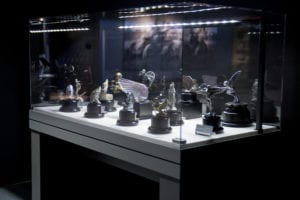Automotive Artifacts: Rolling Sculpture Automotive Mascots

Before the days of vanity plates and bumper stickers, early motorists wanting to separate themselves from the crowd could show off their unique tastes with distinctive mascots. These days, thanks to changing consumer tastes and pedestrian safety regulations, few automakers beyond Mercedes and Rolls Royce even offer the option; however, in the first few decades of the 20th century, consumers could choose from over 7,000 manufactured designs. At the time they were “a way of making something individual and personal” explains Jon Zoler, a Naples resident, art collector, and expert on automotive mascots.
To celebrate these often-forgotten works of art and to showcase the many rare and iconic mascots in the Miles Collier Collections, Revs Institute is hosting an exhibit entitled Rolling Sculpture: Automotive Mascots through the end of the year. In addition to Revs’ permanent mascot display, there are now six exhibit cases packed full of rare mascots positioned throughout the galleries, each with a different theme. The exhibit demonstrates the diversity of automotive mascots and features sculptures of everything from monkeys to airplanes. Whether you wanted to make a statement or simply keep an eye on your engine coolant temperature, there was a mascot to fit anyone’s wants or needs.

Initially, ornaments and good luck charms were mounted to horses and wagons to bring good fortune to their operators. After the arrival of the automobile, the horses were retired, but the good luck charms remained. Owners now mounted these ornaments on the radiator caps of their cars to bring similar good fortune, which would have been especially desirable considering the temperament of early automobiles.
Mascots later became a form of expression and a way to personalize a car to one’s taste. Some mascots were purpose-built and designed by famous sculptors. Others were fashioned out of anything that could be mounted to a radiator cap including paperweights, flagpole finials, and even small sculptures that were never designed for automotive use.

Thirteen of the 74 mascots on display for the exhibit are on loan to the museum courtesy of Jon Zoler. This striking Etling draped female figure from the 1930s, one of the gems in Zoler’s collection, is formed out of white opalescent glass and features an amber core, which creates a stunning effect as light passes through it.
Revs Vice President, Scott George notes, “with the mascot display it allows our visitors to have a broader understanding of this portion of the Miles Collier Collections. We are also very honored and pleased to have local mascot collector and [Naples] resident Mr. Zoler loan us a number of his prized collection pieces for this exhibit.”

Saint George and the Dragon, part of the Mascotte d’Elegance display case, is an example of a sculpture that was later repurposed as a Mascot. This piece was created by Austrian sculptor Carl Kauba and intricately depicts Saint George on horseback slaying a dragon. Kauba went by the pseudonym of Carl Thenn, and he was renowned for this kind of detailed naturalistic style of sculpture.
For those who were more focused on practicality, there were mascots that simply indicated the engine’s coolant temperature. For example, the Boyce Moto-Meter was a temperature gauge mounted to the radiator cap. It can be found adorning the radiators of several cars throughout the galleries at Revs. Not all cars from the period had instruments on the dash to monitor vital engine information and as a result, the Moto-Meter was a popular modification. The gauge, positioned directly in the driver’s field of view, enabled the driver to easily monitor the engine operating temperature and watch for overheating.

Manufacturers also used mascots to create symbols that represented their companies. The most famous example of this is Rolls Royce’s Spirit of Ecstasy, which is still in use today. Sculptor Charles Sykes was commissioned in 1910 by Rolls Royce’s General Managing Director, Claude Johnson, to convey the spirit of Rolls Royce in a mascot. The result was not originally called the Spirit of Ecstasy, but rather the Spirit of Speed. It was meant to embody “speed with silence, absence of vibration, [and] the mysterious harnessing of great energy.”
Mascots remained popular until the mid-1930s when car designers began mounting the radiator under the hood. Since mascots could no longer be mounted onto the radiator, cap manufacturers turned to more cost-effective “hood ornaments” that could be mass-produced. This new style lacked the artistic flair of the previous era and today the hood ornament has all but gone extinct.

If you’re interested in learning more about these automotive artifacts and wish to see them in person, the exhibit remains on display until December 29th, 2018. After that, the Rolling Sculpture display will be replaced by our next exhibit project. Stay tuned for more on that in the coming weeks.